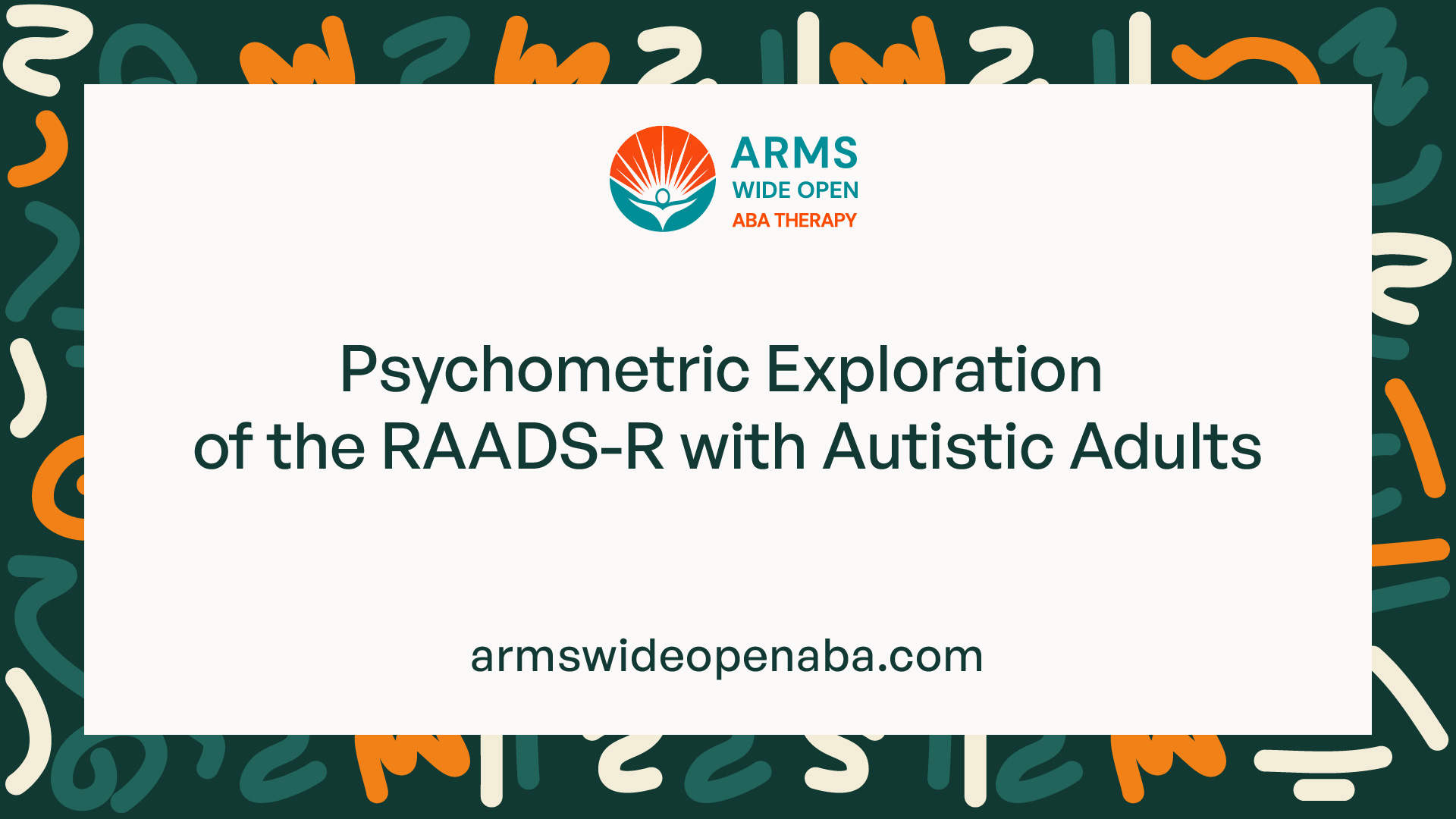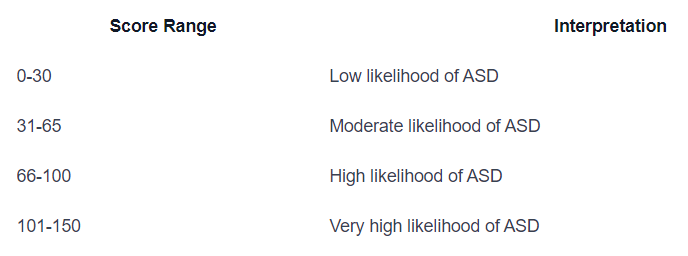Psychometric Exploration of the RAADS-R with Autistic Adults
Discover the RAADS-R assessment: Unraveling autism with psychometric exploration in autistic adults

Understanding Autism
Autism Spectrum Disorder (ASD) is a neurodevelopmental condition characterized by challenges in social interaction, communication, and restricted or repetitive patterns of behavior. It affects individuals across a wide range of abilities and can have a significant impact on their daily lives.

Brief Overview of Autism Spectrum Disorder
Autism Spectrum Disorder is a complex condition that manifests differently in each individual. While the specific symptoms and their severity can vary, some common characteristics include difficulties in social interaction, challenges in verbal and nonverbal communication, and a tendency towards repetitive behaviors or restricted interests.
People with autism may have difficulty understanding and responding to social cues, which can lead to challenges in forming and maintaining relationships. They may also struggle with changes in routine and have specific sensory sensitivities. It is important to understand that each person with autism is unique, and their experiences and abilities can vary widely.
Challenges Faced by Autistic Individuals
Autistic individuals face various challenges in their daily lives, which can impact their overall well-being and quality of life. Some of the common challenges include:
- Social Interaction: Difficulties in understanding and interpreting social cues, which can make it challenging to navigate social situations and build relationships.
- Communication: Difficulties in verbal and nonverbal communication, such as understanding and using gestures, facial expressions, and tone of voice.
- Sensory Sensitivities: Heightened or reduced sensitivity to sensory stimuli, such as light, sound, touch, or taste, which can affect their sensory experiences and comfort levels.
- Executive Functioning: Challenges in planning, organizing, and managing tasks, which can impact their ability to initiate and complete activities independently.
- Emotional Regulation: Difficulties in managing and expressing emotions, which can lead to heightened anxiety or meltdowns in certain situations.
Importance of Psychometric Assessment
Psychometric assessments, such as the RAADS-R (Ritvo Autism Asperger Diagnostic Scale-Revised), play a crucial role in understanding and diagnosing autism in adults. These assessments provide valuable insights into an individual's cognitive and behavioral patterns, helping professionals and researchers gain a comprehensive understanding of autism.
By utilizing psychometric assessments like the RAADS-R, clinicians and researchers can assess the presence and severity of autism-related characteristics. This assessment aids in identifying strengths, weaknesses, and specific areas of need for individuals with autism. It also assists in developing tailored interventions and support services to address their unique requirements.
Psychometric assessments help in gathering objective data, which is essential for accurate diagnosis, treatment planning, and monitoring progress over time. These assessments provide a standardized framework for evaluating autistic traits and behaviors, promoting consistency and reliability in the evaluation process.
Understanding autism and the challenges faced by autistic individuals is crucial for creating a supportive and inclusive society. Psychometric assessments like the RAADS-R contribute significantly to this understanding, enabling professionals to provide appropriate interventions and support tailored to the unique needs of autistic adults.
Introduction to RAADS-R
The RAADS-R (Ritvo Autism Asperger Diagnostic Scale-Revised) is a psychometric assessment tool designed to measure the presence and severity of Autism Spectrum Disorder (ASD) traits in individuals. It provides valuable insights into the autistic characteristics exhibited by adults and aids in understanding their unique needs and challenges.
What is the RAADS-R?
The RAADS-R is a self-report questionnaire that consists of 80 questions. It covers various domains associated with autism, including social interactions, communication, repetitive behaviors, sensory sensitivities, and emotional regulation. The questions are designed to assess the presence and intensity of these traits in autistic adults.
The questionnaire is available in multiple languages and can be completed online or in a printed format. It is an effective tool for gathering information directly from the individual, allowing for a comprehensive evaluation of their autistic traits.
Purpose of the RAADS-R Assessment
The primary purpose of the RAADS-R assessment is to provide a standardized measure for evaluating autism-related characteristics in adults. It serves as a valuable tool for clinicians, researchers, and professionals working with autistic individuals. By using the RAADS-R, they can gain a deeper understanding of the individual's experiences and tailor support and intervention strategies accordingly.
The RAADS-R assessment helps in identifying strengths and challenges specific to the individual, providing a comprehensive profile of their autistic traits. It also aids in distinguishing between autism and other mental health conditions, ensuring accurate diagnoses and appropriate interventions.
Through the use of the RAADS-R, professionals can better comprehend the unique needs of autistic adults, enhancing their ability to provide targeted support and interventions that promote their overall well-being.
To interpret the results of the RAADS-R assessment accurately, it is crucial to understand the scoring system and common patterns in RAADS-R scores, which will be explored in the subsequent sections.
Exploring RAADS-R with Autistic Adults
When it comes to understanding and assessing autism in adults, the RAADS-R assessment tool plays a crucial role. By exploring the RAADS-R with autistic adults, researchers and professionals gain valuable insights into the characteristics and experiences of individuals on the autism spectrum.
Benefits of Using RAADS-R with Autistic Adults
The RAADS-R offers several benefits when used with autistic adults. It provides a standardized and reliable measure to evaluate the presence and severity of autistic traits. By completing the assessment, individuals can gain a better understanding of their own experiences and challenges, which in turn can lead to increased self-awareness and self-advocacy.
For researchers and professionals, the RAADS-R offers a comprehensive profile of an individual's autistic traits across different domains, such as social interaction, communication, and sensory sensitivities. This information can guide the development of tailored support services and interventions that address the specific needs of autistic adults. Additionally, the RAADS-R can aid in the identification and diagnosis of autism, facilitating access to appropriate resources and accommodations.
How RAADS-R Helps in Understanding Autism
The RAADS-R assessment provides valuable insights into the manifestations of autism in adults. It consists of 80 questions that cover a range of autism-related behaviors and experiences. These questions are designed to assess various aspects of autism, including social difficulties, communication challenges, repetitive behaviors, and sensory sensitivities.
By analyzing the responses to the RAADS-R, researchers and professionals can obtain quantitative data that helps them understand the individual's autistic traits. The assessment generates scores in different areas, providing a profile of the individual's strengths and difficulties. These scores can be compared to established cutoffs and norms, enabling a more comprehensive understanding of the individual's autism profile.
To better illustrate the insights offered by the RAADS-R, here is an example table showcasing hypothetical scores in different domains:

The scores obtained from the RAADS-R can help professionals and individuals identify specific areas of strength and areas that may require additional support. This information is valuable for developing personalized interventions and support services that address the unique needs of autistic adults.
Overall, exploring the RAADS-R with autistic adults allows for a deeper understanding of their experiences and challenges related to autism. The assessment provides valuable data that informs the development of individualized interventions and support services, ultimately improving the quality of life for autistic adults.
Interpreting RAADS-R Results
To fully understand the RAADS-R assessment and its implications for autistic adults, it is important to have a clear understanding of the scoring system and the common patterns observed in RAADS-R scores.
Understanding the Scoring System
The RAADS-R assessment uses a scoring system to quantify the presence and severity of autistic traits in individuals. The scoring system consists of a range of scores for each section, with higher scores indicating a higher likelihood of autism spectrum disorder (ASD).
The scoring system for RAADS-R is as follows:

Individuals who score within the higher ranges are more likely to exhibit characteristics associated with autism. It is important to note that the RAADS-R is not a diagnostic tool but rather a measure of autistic traits.
Common Patterns in RAADS-R Scores
While every individual's experience with autism is unique, there are common patterns that can be observed in RAADS-R scores. These patterns can provide valuable insights into the presence and intensity of autistic traits.
- Social Communication: Autistic individuals often show challenges in social communication, such as difficulty understanding social cues, engaging in reciprocal conversations, or interpreting nonverbal signals. Higher scores in the social communication section of RAADS-R may indicate greater difficulties in this area.
- Restricted and Repetitive Behaviors: Autistic individuals may exhibit repetitive behaviors, intense interests, or a need for routine and predictability. Higher scores in the restricted and repetitive behaviors section of RAADS-R may suggest a greater presence of these characteristics.
- Sensory Sensitivities: Many autistic individuals experience sensory sensitivities, such as being hypersensitive or hyposensitive to certain stimuli like noise, light, or touch. Higher scores in the sensory sensitivities section of RAADS-R may indicate a heightened sensory response.
- Cognitive Rigidity: Autistic individuals may demonstrate cognitive rigidity, struggling with changes in routine, difficulties with transitioning between tasks, or a preference for sameness. Higher scores in the cognitive rigidity section of RAADS-R may suggest a stronger inclination toward cognitive inflexibility.
It is important to keep in mind that RAADS-R scores should be interpreted in conjunction with other assessments and clinical evaluations to gain a comprehensive understanding of an individual's autistic traits. The RAADS-R serves as a valuable tool in the assessment process, assisting professionals in identifying areas of strengths and challenges in autistic adults.
By understanding the scoring system and recognizing common patterns in RAADS-R scores, professionals can gain insights into the presence and intensity of autistic traits in individuals. This information can inform personalized support services and interventions tailored to meet the unique needs of autistic adults.
Using RAADS-R for Support and Intervention
When it comes to supporting autistic adults, the RAADS-R assessment plays a valuable role in tailoring support services and developing individualized interventions. By analyzing the results obtained from the RAADS-R, professionals can gain a deeper understanding of an individual's autistic traits and challenges, allowing them to provide more targeted and effective support.
Tailoring Support Services Based on RAADS-R Results
The RAADS-R assessment provides valuable insights into an individual's autistic characteristics and their impact on daily life. By considering the results of the assessment, support services can be tailored to meet the specific needs of each individual.
Table: Example of Tailored Support Services based on RAADS-R Results

By using the RAADS-R results as a guide, professionals can design support programs that address the unique challenges faced by autistic individuals. This personalized approach ensures that the support services are effective and relevant to the individual's specific needs.
Role of RAADS-R in Developing Individualized Interventions
Interventions for autistic adults can greatly benefit from the insights provided by the RAADS-R assessment. The assessment results help professionals identify the areas where individuals may require additional support or intervention.
By understanding an individual's specific autistic traits and challenges, professionals can develop interventions that target those areas directly. This could include specialized therapies, social skills training, cognitive-behavioral interventions, or other evidence-based approaches.
The RAADS-R results also help professionals establish baseline measurements, allowing them to track progress over time and make adjustments to the intervention strategies as needed. By regularly reassessing the individual's RAADS-R scores, professionals can evaluate the effectiveness of the interventions and make informed decisions about ongoing support.
Overall, the RAADS-R assessment serves as a valuable tool in guiding the development of individualized interventions for autistic adults. By tailoring support services based on the assessment results and utilizing evidence-based interventions, professionals can enhance the quality of life and well-being of autistic individuals, empowering them to thrive in their unique journey.
Sources
https://pubmed.ncbi.nlm.nih.gov/38305196/
https://journals.sagepub.com/doi/pdf/10.1177/13623613241228329?download=true
Similar articles
We’re here to help you

Our team is here to assist you in this process. Contact us for any assistance.
it’s easy to apply
We Accept Most Insurances
Our in-network insurance partnerships make ABA therapy more accessible to families throughout our service areas.







Our Insurance Process
We'll request your insurance details to help us verify your plan's coverage for ABA therapy. Once we've received this information, we'll walk you through your benefits, including copayments, deductibles and out-of-pocket maximums, so you know what to expect in advance.
Our team will then handle the preauthorization and all the necessary paperwork.
.svg)





















.jpeg)


































.jpeg)




.jpeg)







.jpeg)











.jpeg)
















